|
My Biography _____________________________
I grew up hunting and
shooting on a small farm in Kansas. After college, a move to Colorado led
to an interest in mountain men and their firearms and other gear.
I was fortunate to learn primitive
skills and rifle stocking from a number of talented men.
I could not afford to buy a fine rifle
with the family’s meager income, so set about learning to build myself.
A Hawken Shop catalog provided
guidance, and Dave Rase showed me the basics of tools and their use.
Dick Hart and Ted Holland shared info on rifle design and finishing, and
Joe Corley and I worked together on various projects. Several local black powder shops
encouraged me and offered my work for sale.
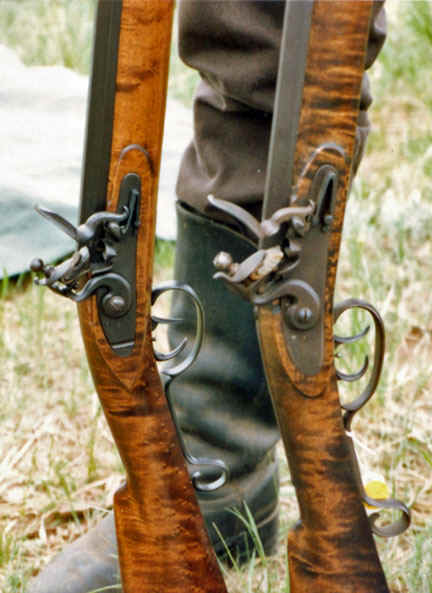
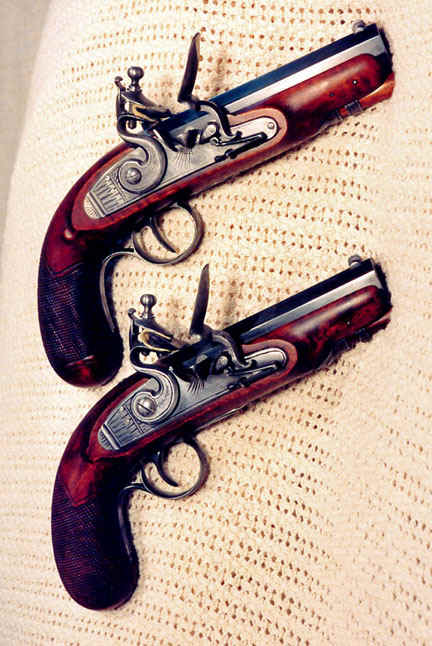
Pair of (fantasy) fullstock flint Hawkens and large bore flint pistols
with belt hooks.
As I studied the old guns
at the Museum of the Fur Trade and collector shows, I came across the
work of Henry Leman, J. J Henry and others. I continued stocking “mountain man
rifles” from the late 70’s through the 80’s, building trade rifles of
various patterns, fusils and pistols.

My first
Leman – "typical", as I averaged details from all that I had seen to
this point.

Another early
Leman rifle, one of several rifles and pistols made for the 2003 Alamo
movie.
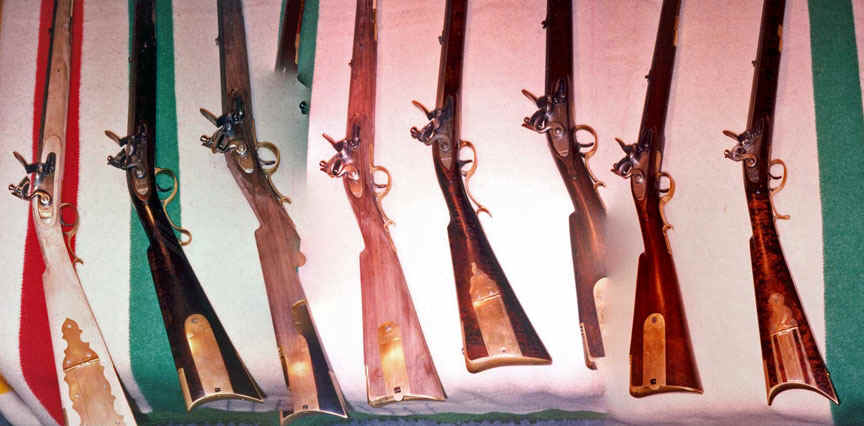
Composite of
three styles of Henry trade rifles – full custom rifles, as we had to
make locks and all mounts, ordered barrels to match the old ones. Plus a
1780 longrifle and Leman.

Bob with
trade blanket at “Wet Moccasin Basin” joint national rendezvous near
Dubois, Wyoming in 1987 – arms and trade goods for the western fur trade.
My interests
gradually worked backwards in time, through the Henry family for
example, from J. Henry to John Joseph Henry, to William Henry, Jr. and
finally to William Henry. Similarly from T. J. Albright at St. Louis to
his father Henry Albright of Ohio and Pennsylvania, and his father
Andreas Albrecht who learned the trade of gunstocker in Germany. After
ten years of Hawkens, trade rifles and self-learning, Jack Brooks agreed
to teach me to build a longrifle from scratch.
.
..

First scratch
built rifle with Jack Brooks, after Klette of Virginia ca 1780.
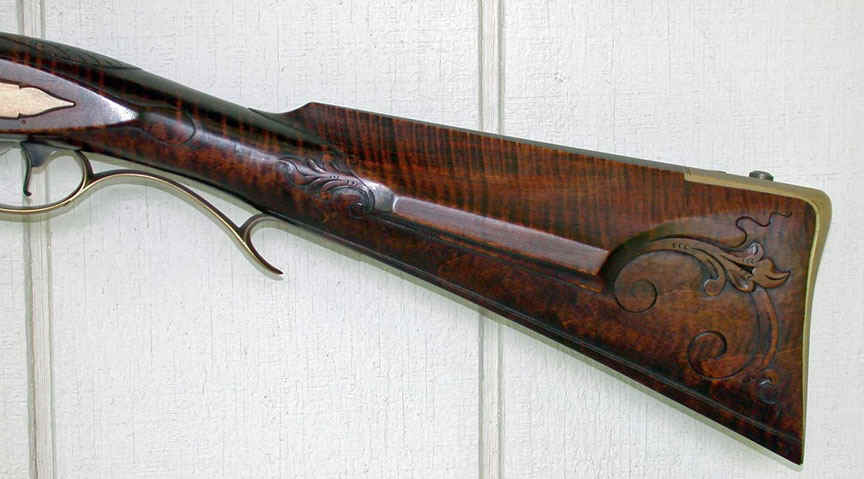
Cheek side
with custom mounts, relief carving and scraped finish – no sandpaper!
Now I had an
"original"- properly built after an old rifle as a three dimensional
reference to guide future work. Jack continues to teach, and sometimes
provides engraving or wire inlay when especially fine work is required.
More rifles, fowlers and pistols of earlier periods followed.
.
.

Ca 1770 rifle
– stock and mounts copied from original, then wire added in style of
Oerter.

Ca 1790 rifle
after John Noll, fancy patchbox, carving and engraving from the Golden
Age.
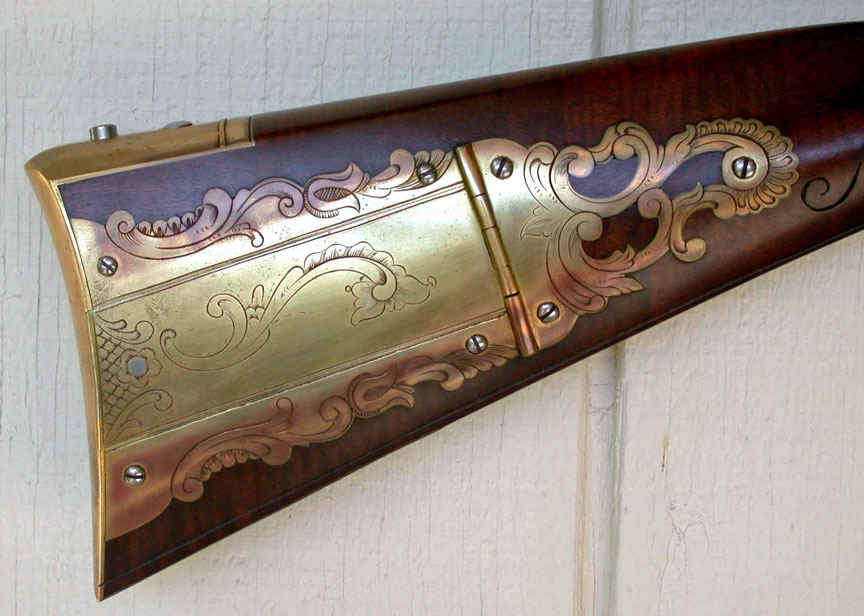
Patchbox
detail after John Noll, designed and stocked by Bob, engraved by Jack
Brooks

Bob at left and good friend / master gunsmith
Jack Brooks in 2002 with a pair of ca 1830 trade rifles -
these and a variety of
other rifles and pistols were made for the 2003 Alamo movie

Ca 1820 –
1860 southern mountain rifle, as long and slender as possible, simple -
good lines.
Anxious to learn more and to see original
material, I joined the Kentucky Rifle Association, traveled to
Pennsylvania and North Carolina whenever possible, and found many new
friends and teachers. As I learned more about the firearms, I became
interested in the lives of the locksmiths and gunstockers - the world
they lived and worked in. It seemed that stocking a rifle made me a
better student and collector, and study in turn made me a better
stocker.
.
A particular recent
focus has been the locksmiths and gunstockers within the Moravian
settlements in Pennsylvania and North Carolina, begun in the 1740’s.
These first tradesmen learned their craft in Germany, traveled Europe as
journeymen before being sent here as missionaries. Several have had a
profound impact on longrifle design and decoration here in the colonies.
This study resulted in a book published by the Kentucky Rifle
Association and Foundation in 2010. A larger manuscript is nearing
completion, and a related article was published in 2014 in American
Tradition, magazine of the Contemporary Longrifle Association.

.
However, I’ve always been a hobby gunstocker. As I’ve learned more about
the men and boys who made the old rifles, I enjoy stocking contemporary
rifles in their styles. Arms for the mountain men are returning to
popularity, and I’ve just finished a Hawken pistol with friend Joe
Corley. Other projects from 1740 to 1840 are on the bench or in planning
stages.
And the very best
part of this interest – I now have great friends from around this
country and a few in Europe, where this all began.
Thank you! |
.
.
|